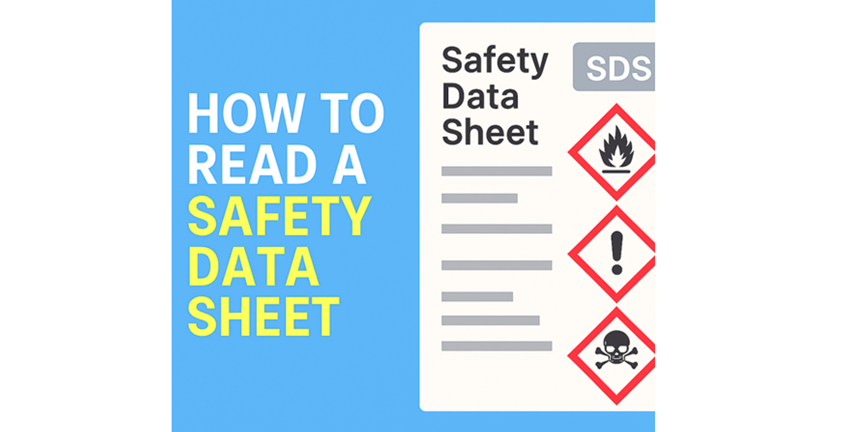What is an SDS...

🧪 How to Read a Safety Data Sheet (SDS): A Practical Guide for Businesses
When you purchase cleaning chemicals, especially in bulk, you’re not just buying a product - you’re taking on a responsibility. That’s why every chemical sold by Astral Hygiene comes with a Safety Data Sheet (SDS): A legally required document that helps you understand how to store, handle, and use the product safely.
But let’s be honest - SDSs can look intimidating. So here’s a breakdown of the most important sections, with real-world context to help you make sense of it all.
📄 What Is an SDS?
An SDS is a 16-section document required by law under the REACH Regulation (EC) No 1907/2006. It provides comprehensive safety information about a chemical product - from its ingredients to emergency procedures.
Think of it as your chemical’s instruction manual, risk assessment, and emergency guide all rolled into one.
🔍 Key Sections Explained
1. Identification
-
What it tells you: The product name, supplier contact details, and emergency phone numbers.
-
Why it matters: If there’s an incident, you need to know who to call and what product you’re dealing with. This section also confirms the intended use - for example, “surface disinfectant for food prep areas.”
2. Hazards Identification
-
What it tells you: Whether the product is flammable, corrosive, toxic, or environmentally hazardous.
-
Look for:
-
Signal words: “Danger” indicates a higher level of risk than “Warning.”
-
Hazard pictograms: Red diamond symbols like the flame 🔥, skull ☠️, or exclamation mark ❗.
-
-
Why it matters: Helps you assess risk and determine what PPE (personal protective equipment) is needed.
3. Composition/Ingredients
-
What it tells you: The chemical makeup of the product, including active ingredients and their concentrations.
-
Why it matters: Useful for checking compatibility with your workplace, especially if you have sensitive environments like food production or healthcare.
4. First Aid Measures
-
What it tells you: What to do if someone inhales, ingests, or comes into contact with the chemical.
-
Why it matters: Quick access to this info can prevent serious harm. For example, some disinfectants require rinsing with water for 15 minutes if they contact skin.
5. Fire-Fighting Measures
-
What it tells you: Suitable extinguishing methods and any special hazards during combustion.
-
Why it matters: Some chemicals release toxic fumes when burned - knowing this helps fire marshals and emergency responders.
6. Accidental Release Measures
-
What it tells you: How to clean up spills safely and prevent environmental damage.
-
Why it matters: If a drum leaks in your storeroom, this section tells you whether to ventilate, evacuate, or use absorbent materials.
7. Handling and Storage
-
What it tells you: Conditions for safe handling, including temperature, ventilation, and container compatibility.
-
Why it matters: Improper storage can degrade the product or create hazards. For instance, some disinfectants must be kept away from direct sunlight or heat sources.
8. Exposure Controls / PPE
-
What it tells you: Workplace exposure limits and recommended protective gear.
-
Why it matters: Ensures your staff are protected. If the SDS recommends nitrile gloves and splash goggles, don’t substitute with latex and safety glasses.
9. Physical and Chemical Properties
-
What it tells you: Appearance, odour, pH level, boiling point, etc.
-
Why it matters: Helps you identify the product and understand how it behaves. For example, a low pH might indicate corrosiveness.
10-16. Stability, Toxicology, Disposal & Transport
-
What it tells you:
-
Whether the product reacts with other chemicals.
-
Long-term health effects.
-
How to dispose of it safely.
-
Transport classifications (e.g., flammable liquids).
-
-
Why it matters: These sections are vital for bulk buyers, logistics teams, and anyone managing chemical waste.
🧤 Why This Matters for Your Business
-
Legal Compliance: SDSs are required under COSHH regulations. Not having them accessible can result in fines.
-
Risk Management: Prevent accidents, protect staff, and reduce liability.
-
Training: Use SDSs to educate your team on safe handling and emergency response.
-
Storage Planning: Know which chemicals can be stored together - and which combinations are dangerous.
✅ Astral Hygiene Tip
When you receive a new product:
-
Print the SDS and store it in your COSHH folder.
-
Train your staff on key sections relevant to their role.
-
Review storage instructions before placing it in your storeroom.
Need help building a COSHH folder or training your team? Astral Hygiene is here to support you - just reach out.








